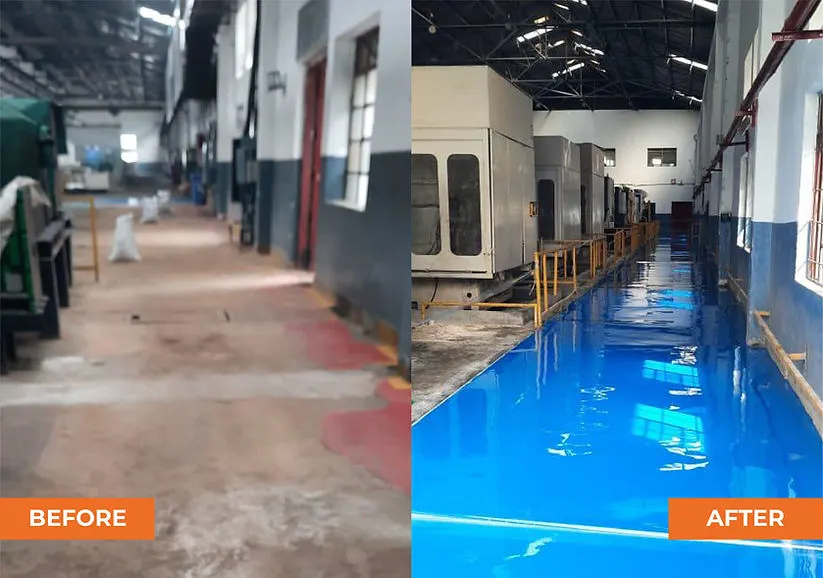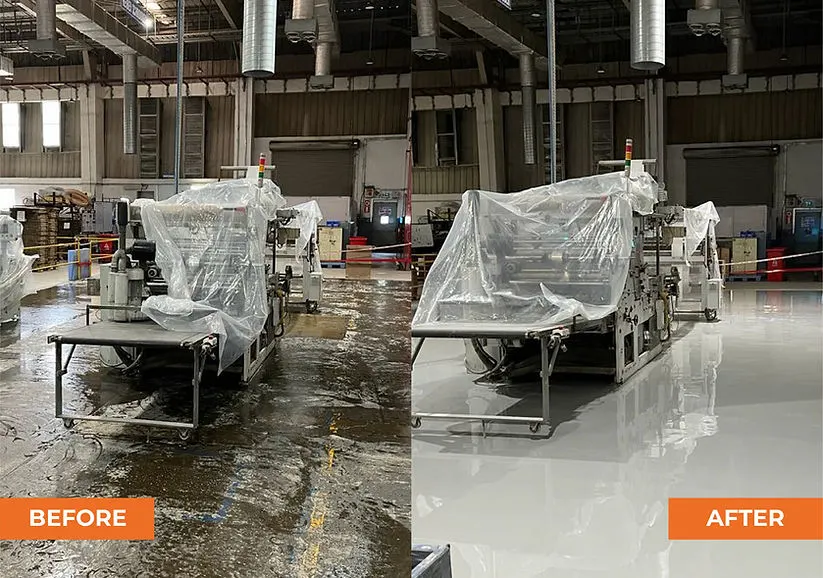Form submitted successfully!
Experience the superior performance and lasting beauty of floors designed for diverse conditions.
RachTR epoxy flooring guarantees self-levelling properties for a perfect finish, reducing installation time
RachTR epoxy flooring guarantees self-levelling properties for a perfect finish, reducing installation time
RachTR's anti-static properties reduce static build-up, ideal for areas where static discharge can be a concern.
When considering epoxy flooring price per sq ft, these factors play a critical role in determining the overall budget for your industrial epoxy flooring project.
Click here to get a customized epoxy flooring quote!
Welspun were facing issues of excessive oil on the floor, which caused the debonding between epoxy flooring and concrete.
Check out how RachTR fixed this issue by clicking on the "View Case Study" button.
View Case Study

ITC facility at Haridwar faced themselves with issues of broken tiles and slippery surface which often caused an issue for the workers at the facility.
Check out how RachTR fixed this issue by clicking on the "View Case Study" button.
View Case Study

Delhivery, a logistics company, likely faced the challenge of needing a durable and chemical-resistant floor for one of their warehouses in Faridabad.
Check out how RachTR fixed this issue by clicking on the "View Case Study" button.
View Case Study


*Note: RachTR doesn’t do Residential Interior Epoxy Flooring projects!
The cost of epoxy flooring is typically priced per square foot (Rs. / sq. ft.) or per square meter (Rs. / sq. meter).
Several factors influence the total cost of your project, including:
RachTR offers a comprehensive warranty on its epoxy flooring products. Please refer to our official page or contact us for details.
Heat is released during the chemical reaction that converts liquid part A and part B into solid epoxy. The amount of heat released depends on the epoxy’s chemistry and the amount of epoxy used. That is, a certain amount of mixed part A and part B will result in the release in a certain amount of heat.
The curing epoxy must be able to shed the heat it generates efficiently enough to avoid overheating. The ability to shed heat is largely governed by the ratio of top surface area that is open to the air relative to the volume.
For the same resin system, thinner castings will have greater top surface areas in comparison to overall volume and will shed heat more efficiently. Thicker castings cannot shed heat as efficiently and may overheat.
For the same volume of epoxy, a thinner casting will have a larger top surface area and will shed heat more efficiently compared to a thicker casting with a smaller top surface area.

EcoPoxy systems are developed to have reactivity levels suited to their intended applications. Always consult your product’s Technical Data Sheet or Application Guide for recommended volume and thickness.
Cured epoxy resin is inert and should be disposed of as you would other solid non-hazardous waste. Uncured resin, or residue left over in jugs, must be disposed of properly as the hardener and resin are unreacted. If the jugs have been sufficiently drained, they may be recycled but the amount of allowable residue will be determined by your local hazardous waste collection center and the prevailing regulations. When contacting your local waste collection center, you will need the Safety Data Sheets that are available for download from our website.
Epoxy releases heat when curing. EcoPoxy makes recommendations for maximum project volumes and/or thicknesses to allow projects to shed heat efficiently and prevent overheating and yellowing. If the recommended maximum pour depth and volume are exceeded, the epoxy will not be able to shed heat quickly enough, and the temperature will increase uncontrollably. Cure temperatures that reach 100°C (212°F) for extended periods are known to cause yellowing, and extremely high temperatures can cause epoxy to amber and form cracks. If a deeper pour is required for a project, it is recommended to pour multiple layers to build up to the desired final thickness.
During the curing process, epoxy resins and hardeners form crosslinks that cannot easily be broken. Technologies are being developed to break down these types of plastics for recycling, or via other biodegradation methods, but none are readily accessible. Practically, this means that all epoxy resin systems are neither biodegradable nor recyclable.
Simply fill out the form by clicking here, and a RachTR representative will contact you to discuss your project and provide a free quote.